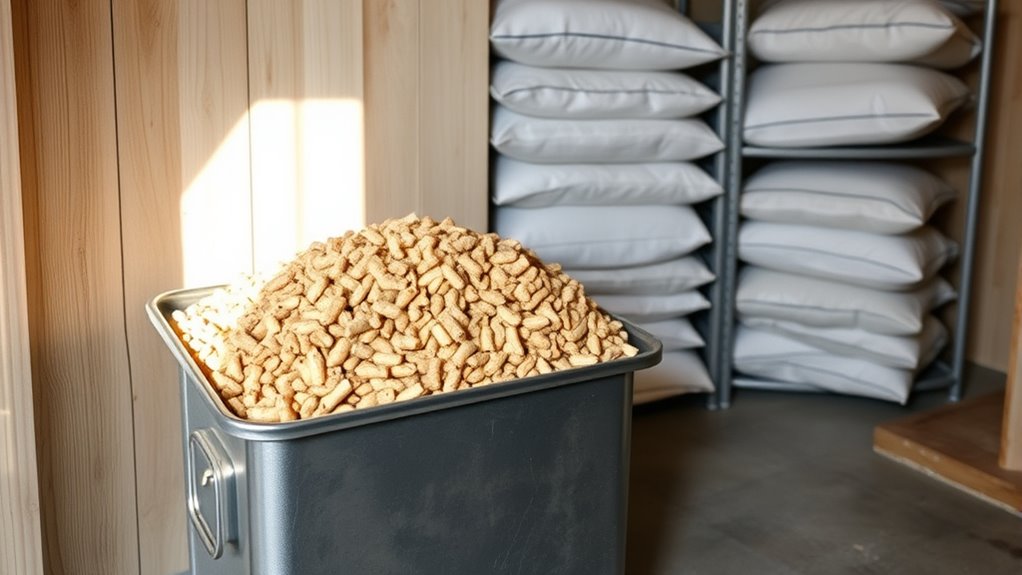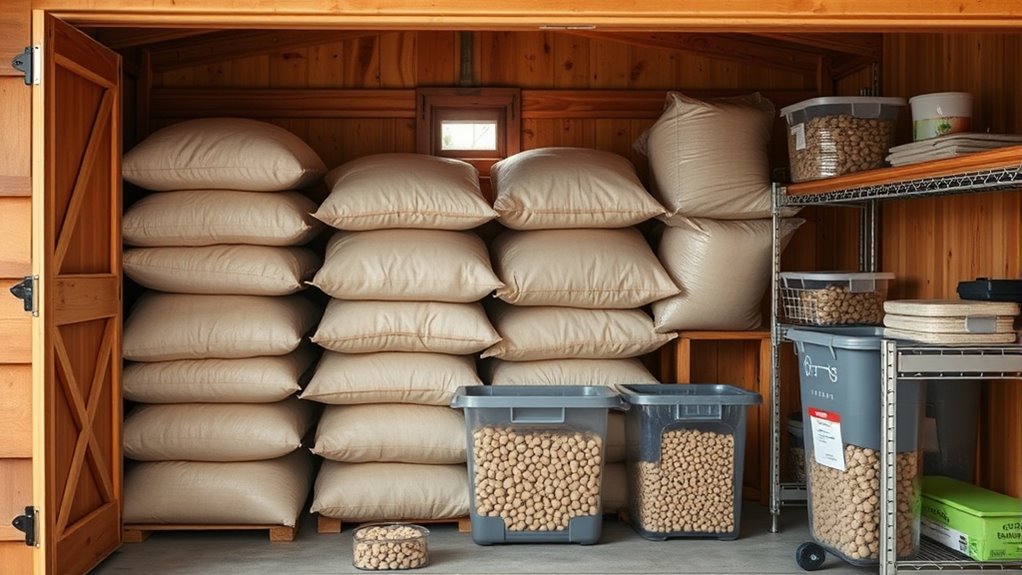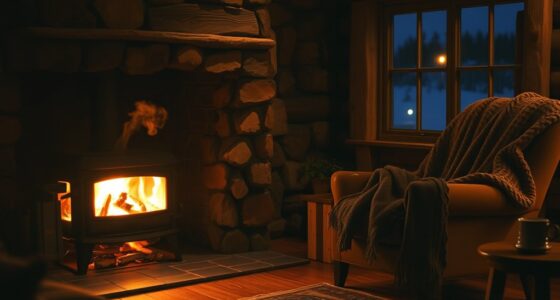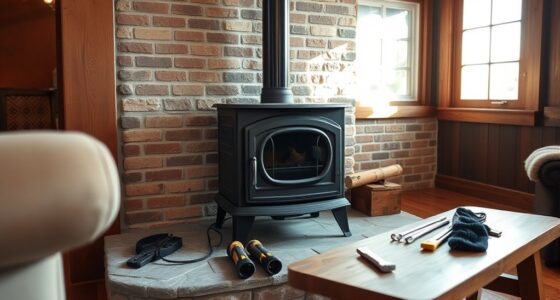To store pellets for your pellet stove, keep them in a dry, well-ventilated area away from direct sunlight. Use airtight metal or plastic containers to prevent moisture and pests from getting in. Elevate the containers on pallets or shelves to avoid dampness from the ground. Regularly check for signs of moisture or pests, and consider covering outdoor storage with waterproof tarps. To find out more, explore effective storage tips to keep your pellets in top condition.
Key Takeaways
- Store pellets in a dry, well-ventilated area away from direct sunlight.
- Use airtight, weatherproof containers like plastic bins or metal barrels.
- Keep pellets off the ground on pallets or shelves to prevent moisture absorption.
- Regularly inspect storage for signs of moisture, pests, or contamination.
- Cover outdoor containers with waterproof tarps, ensuring proper airflow.

Storing your pellets properly is vital to keep them dry, clean, and ready for efficient burning. When pellets absorb moisture, their combustion quality drops considerably, leading to inefficient heat output and increased ash production. To prevent this, you need to pay close attention to pellet moisture levels and choose the right storage containers. High-quality storage containers are designed specifically to protect your pellets from the elements, keeping them dry and free from contamination. These containers should be airtight or have secure lids to reduce exposure to humidity and rain. If your storage area isn’t climate-controlled, using sealed plastic bins or metal containers can make a big difference in maintaining pellet quality.
It’s important to keep your pellets off the ground, as moisture can seep in from damp floors or surfaces. Elevating your storage containers on pallets or shelves creates better airflow and minimizes contact with damp surfaces. When selecting storage containers, look for ones that are durable and resistant to cracking or rust, especially if you live in a humid climate. Clear plastic bins are convenient because you can see the contents without opening them, but ensure they have tight-fitting lids to prevent moisture ingress. Metal containers with secure lids are an excellent choice for long-term storage, as they provide a robust barrier against moisture and pests.
The environment around your storage area plays a vital role in maintaining pellet quality. Choose a dry, well-ventilated space away from direct sunlight, which can cause temperature fluctuations that lead to condensation. Keep your pellets in a cool area, ideally indoors, where humidity levels are controlled. If outdoor storage is your only option, invest in a weatherproof, airtight container designed specifically for pellet storage. Covering the container with a waterproof tarp can add an extra layer of protection, but ensure it’s not sealed so tightly that moisture gets trapped inside. Regularly inspect your storage setup to catch any signs of moisture or pests early. Properly stored pellets stay dry, burn more efficiently, and produce less ash, saving you time and money in the long run. Using appropriate storage options is crucial to prevent moisture damage and ensure optimal pellet performance.
Frequently Asked Questions
How Long Can Pellet Fuel Be Stored Without Degrading?
You can typically store pellet fuel for about six to twelve months without degrading if you keep it dry and protected. To guarantee longevity, maintain low pellet moisture levels and store at moderate temperatures, ideally in a cool, dry place. High moisture or heat can cause pellets to break down or rot, reducing their efficiency. Regularly check your storage conditions and keep pellets sealed to maximize their shelf life.
Can I Store Pellets Outdoors Safely?
Storing pellets outdoors is like leaving a treasure chest open to the elements—you risk moisture and pests. To keep them safe, use a weatherproof container with a tight seal, and elevate it off the ground for proper drainage. Protect your investment by practicing pest prevention, like sealing any gaps and keeping the area clean. This way, your pellets stay dry, fresh, and ready when you need them most.
What Are Signs of Pellet Spoilage or Mold?
You can spot pellet spoilage or mold by checking for signs like a musty smell or visible mold growth. If the Pellet moisture increases, pellets become soft or damp, which promotes mold detection. Moisture encourages mold, so always guarantee your pellets are dry and stored in a cool, dry place. Discard any pellets that feel damp, smell off, or show mold, as burning them could release harmful spores.
Is It Necessary to Rotate Pellet Stock?
You should rotate your pellet stock to guarantee freshness and prevent spoilage. Store your pellets on indoor shelving in a cool, dry place, and use the older ones first. Regularly check for signs of mold or moisture damage. By rotating your pellets and keeping them well-ventilated, you maintain their quality and optimize your pellet stove’s performance, avoiding issues caused by stale or damp pellets.
How Do I Prevent Pests From Contaminating Stored Pellets?
To prevent pests from contaminating your stored pellets, you should focus on pest prevention through proper storage tips. Keep pellets in airtight, sealed containers or bins to block pests’ access. Store them in a cool, dry place away from food or waste. Regularly inspect your storage area, and consider adding natural pest deterrents like cedar chips or diatomaceous earth. These steps help maintain pellet quality and avoid pest issues.
Conclusion
So, after all that fuss, you might think storing pellets is a huge ordeal. But really, it’s just about keeping them dry and out of the way—nothing fancy. Ironically, the simplest method is often the best, proving that even with all the tips, the easiest solution is just a sturdy container and a little common sense. Who knew that something so small could be so tricky? Now, go ahead and enjoy your cozy, pellet-powered warmth!










